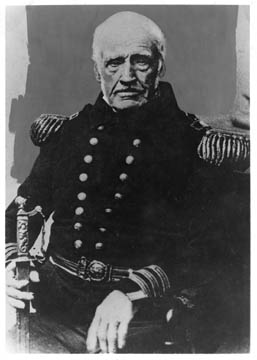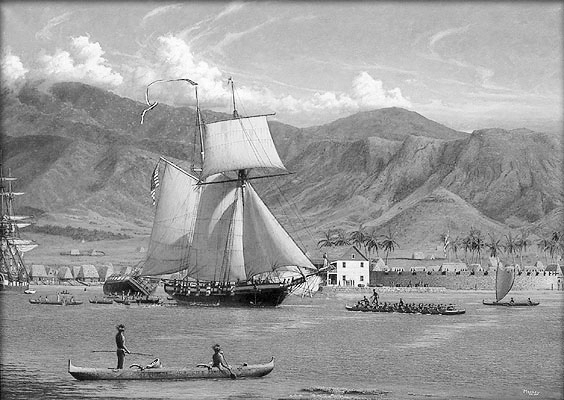

The Battle of Honolulu
By Dr. T. Lowry
Excerpted with permission
of the publishers from "The Story the Soldiers Wouldn't Tell"
Stackpole
Books, 5067 Ritter Road, Mechanicsburg, PA 17055
Augmented from additional
sources by Chuck Veit
It's
a damned tough life, full of toil and strife, we whalermen undergo.
And we don't give a damn when the gale has stopped how hard the wind did blow.
We're homeward bound! 'Tis a grand old sound on a good ship taut and free,
And we don't give a damn when we drink our rum with the girls on old
--Rolling Down to Old
The
When
the general population saw that the white sailors did as they pleased, the
sailors were accorded status as aristocracy, almost demigods. These seafarers,
whether from whaling ships or merchant vessels, were largely illiterate,
hard-living, working class men, used to bad pay, worse food, violent discipline,
and low status. They were understandably delighted to be suddenly accepted into
the top ranks of society, with unlimited access to women and power. The
Hawaiians had a very open view of sexual behavior (in vivid contrast to early
Victorian age
Parallel
with this influx of opportunists was the continuing epidemic, now waxing, now
waning, of venereal disease. The British had landed on
Thus
two cultures were on a fatal collision course. The Hawaiians had lost all faith
in their gods; their new king, the young Liholiho, had declared the old religion
dead. Since the aristocracy and the old priesthood were mutually supportive, the
mandate for governance was gone. The whites, mostly renegade sailors turned
economic and sexual exploiters, were gaining power and land (and owned the best
weapons). With the old culture dead and the new culture a mixture of anarchy,
greed, and societal collapse, there seemed no future for the Hawaiians.
At
this propitious moment, in 1820, an alternative arrived aboard the ship Thaddeus:
the first of the American missionaries. The Hawaiians, desperate from the loss
of their own belief system, willingly embraced this new world view. There was an
almost-instantaneous mass conversion to Christianity. From the aristocracy
downward, the new teaching took hold. And almost the first stricture was the new
taboo: no more indiscriminate sexual intercourse.
A
U.S. Navy ship, the 12-gun schooner Dolphin,
Lt. Jack Percival commanding, arrived in
 |
The lieutenant commanding Dolphin
was one of the most colorful officers ever to serve in the United States
Navy, John “Jack” Percival. Born in |
Under cover of nightfall, he led raiding parties ashore to strike at
pirate island strongholds, leaving dead buccaneers and bastions ablaze
throughout the
“Mad Jack” Percival demanded an audience with Prime Minister Kalanimoku and the Dowager Queen (and regent) Kaahumanu. In his message, Percival asserted that denying women to his crew was an insult to the American flag. The Queen replied, in a letter, that she had a right to control her own subjects; that in punishing her offending subjects she had done no injustice to other nations and that she sought only to save her own nation from vice and ruin. She further reminded Percival that strangers in a new country are expected to follow the laws and customs of their hosts.
The
governor of
The
next day was the Sabbath. In the afternoon, as the royal family gathered in the
prime minister’s home for divine services, 150 drunken sailors (merchant
seamen had joined the Navy men) arrived, repeated their demands for women, made
loud threats, and then smashed seventy windowpanes. A contingent proceeded on to
the home of Hiram Bingham, the leader of the missionaries. Mrs. Bingham locked
the front door, and the sailors proceeded to smash in her windows. Forcing their
way inside, the mob found Bingham himself, surrounded him, cursed him loudly,
and menaced him with clubs and knives. A group of Hawaiian men, warriors and
Christian converts, stood calmly by; they told Bingham no harm would come to
him. When the first American sailor actually struck a blow at Bingham, the riot
was over. The Hawaiians clubbed the ringleaders unconscious and disarmed the
remainder. The sailors still able to walk were sent back to the ships, their
arms bound tightly. Another group, which had
returned to Bingham’s home and was attempting to break down the door, was
interrupted by the ship’s officer and beaten—including “Mad Jack,”
wielding a whalebone cane.
In
the late afternoon, Percival appeared, grudgingly admitted that his men had gone
too far, and repeated his demand for women. In fact, he said that the Dolphin
would not leave
Mad
Jack’s actions were later renounced by the
Captain
Percival will forever be remembered for the years from 1841 to 1846 during which
time he was associated with USS Constitution.
In fact, Percival is credited with saving "Old Ironsides" from being
scrapped when the Navy Department deemed her beyond repair. According to the
Navy, repairs would cost $150,000, a fortune in those days. Percival scoffed at
the Navy's claim and price tag, and promised that he could oversee the repairs
for a mere $10,000. Percival was true to his word, and when the repairs were
concluded for the specified $10,000 in 1844, the Navy placed "Mad
Jack," then sixty-five years of age, in command with orders to sail the
grand warship around the world. The voyage lasted for nearly five hundred days,
covering more than 50,000 miles and forever established the vessel and the man
as U.S. Navy institutions. Percival peacefully passed away in his sleep in

____________________
Sources:
The Story the Soldiers Wouldn't Tell: Sex in the Civil War, Dr. Thomas P.
Lowry
Virtual
Hawaiian history at http://www.unitedstatestourism.com/world_travel/hawaii/hawaii_history.htm
Cape Cod Companion entry for “Mad Jack” Percival at http://www.barnstablepatriot.com/cccompanion/chapter6.html
The U.S. Navy in
Ship Store Galleries, “USS Dolphin Departing Honolulu” at http://www.shipstoregalleries.com/fineart/artists/massey/orig/dolphin_honolulu_o.html
Find-a-Grave
entry for Jack Percival at http://www.findagrave.com/
Dorchester Reporter article by P. F. Stevens, “Captain
‘Mad Jack’ Percival of Meeting House Hill” at
http://www.dotnews.com/percival.html